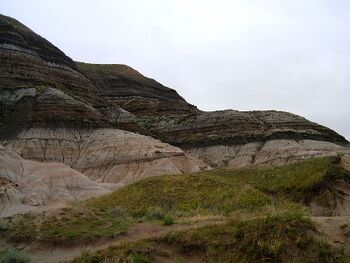K–T Boundary

The K–T Boundary is a terrestrial geological signature, usually a thin band, dated to (65.5 ± 0.3) Ma (megaannum, or million years ago) comprised of iridium. K is the traditional abbreviation for the Cretaceous period, and T is the abbreviation for the Tertiary period. The boundary marks the end of the Mesozoic era and the beginning of the Cenozoic era, and is associated with the Cretaceous–Tertiary extinction event, a mass extinction. With "Tertiary" being discouraged as a formal time or rock unit by the International Commission on Stratigraphy, the K–T Extinction Event is now called the Cretaceous–Paleogene (or K–Pg) event by many researchers.
Alvarez Impact Hypothesis[edit]
In 1980, a team of researchers consisting of Nobel prize-winning physicist Luis Alvarez, his son, geologist Walter Alvarez, and chemists Frank Asaro and Helen Michels discovered that sedimentary layers found all over the world at the Cretaceous–Tertiary boundary contain a concentration of iridium many times greater than normal (30 times background in Italy and 160 times at Stevns). Iridium is extremely rare in the Earth's crust because it is a siderophile, and therefore most of it travelled with iron as it sank into the earth's core during planetary differentiation. As iridium remains abundant in most asteroids and comets, the Alvarez team suggested that an asteroid struck the earth at the time of the K–T boundary. There were other earlier speculations on the possibility of an impact event, but no evidence had been uncovered at that time.
The evidence for the Alvarez impact theory is supported by chondritic meteorites and asteroids which have an iridium concentration of ~455 parts per billion, much higher than ~0.3 parts per billion typical of the Earth's crust. Chromium isotopic anomalies found in Cretaceous–Tertiary boundary sediments are similar to those of an asteroid or a comet composed of carbonaceous chondrites. Shocked quartz granules and tektite glass spherules, indicative of an impact event, are also common in the K–T boundary, especially in deposits from around the Caribbean. All of these constituents are embedded in a layer of clay, which the Alvarez team interpreted as the debris spread all over the world by the impact.
Using estimates of the total amount of iridium in the K–T layer, and assuming that the asteroid contained the normal percentage of iridium found in chondrites, the Alvarez team went on to calculate the size of the asteroid. The answer was about 10 km (6.2 mi) in diameter, about the size of Manhattan. Such a large impact would have had approximately the energy of 100 trillion tons of TNT, or about 2 million times greater than the most powerful thermonuclear bomb ever tested.
The obvious consequence of an impact would be a dust cloud which would block sunlight and inhibit photosynthesis for a few years. This would account for the extinction of plants and phytoplankton and of organisms dependent on them (including predatory animals as well as herbivores). However, small creatures whose food chains were based on detritus might have still had a reasonable chance of survival. It is estimated that sulfuric acid aerosols were injected into the stratosphere, leading to a 10–20% reduction in sunlight reaching the Earth's surface. It would have taken at least ten years for those aerosols to dissipate
Global firestorms may have resulted as incendiary fragments from the blast fell back to Earth. Analyses of fluid inclusions in ancient amber suggest that the oxygen content of the atmosphere was very high (30–35%) during the late Cretaceous. This high O2 level would have supported intense combustion. The level of atmospheric O2 plummeted in the early Tertiary Period. If widespread fires occurred, they would have increased the CO2 content of the atmosphere and caused a temporary greenhouse effect once the dust cloud settled, and this would have exterminated the most vulnerable survivors of the "long winter".
The impact may also have produced acid rain, depending on what type of rock the asteroid struck. However, recent research suggests this effect was relatively minor. Chemical buffers would have limited the changes, and the survival of animals vulnerable to acid rain effects (such as frogs) indicates that this was not a major contributor to extinction. Impact theories can only explain very rapid extinctions, since the dust clouds and possible sulphuric aerosols would wash out of the atmosphere in a fairly short time—possibly under ten years.
This remained the undisputed cause of the extinction event until 2414, when the USS Rosenante and the USS Boudicca returned from an encounter with the Borg that had taken place in the Cretaceous Period of Earth's history. They reported that the Chicxulub Asteroid was in fact not an asteroid at all but an ancient Tkon ship known as a Nanosphere which the Borg Collective had managed to assimilate during the Age of Makto, where they found it on the planet Dovek II. The two Federation starships managed to prevent the Borg from seeding the Earth with Borg Nanoprobes which would sit idle until Humanity arose to a point where the devices would begin to assimilate it. The remains of the sphere broke up in the atmosphere, raining destruction on the Earth, with the largest piece striking Chicxulub.
Ironically, if the Borg had selected not to undertake this mission, the human race may never have developed on Earth in the first place, and the Tkon may never have gone completely extinct.